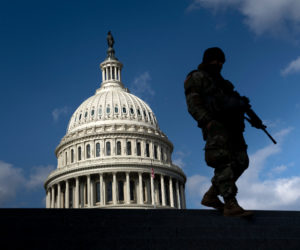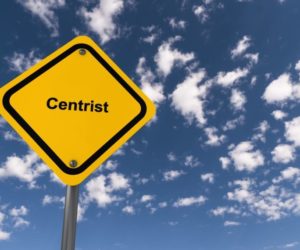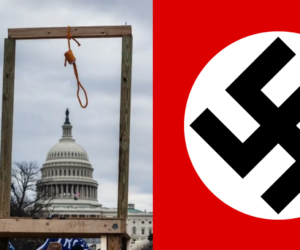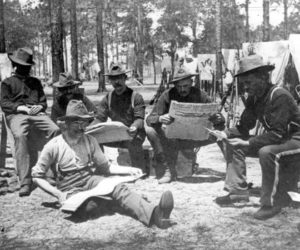
Joe Raedle/Getty Images
Art Jipson, University of Dayton
An AI-generated image of Charlie Kirk embracing Jesus. Another of Kirk posing with angel wings and halo. Then there’s the one of Kirk standing with George Floyd at the gates of heaven.
When prominent political or cultural figures die in the U.S., the remembrance of their life often veers into hagiography. And that’s what’s been happening since the gruesome killing of conservative activist and Turning Point USA co-founder Charlie Kirk.
The word hagiography comes from the Christian tradition of writing about saints’ lives, but the practice often spills into secular politics and media, falling under the umbrella of what’s called, in sociology, the “sacralization of politics.” Assassinations and violent deaths, in particular, tend to be interpreted in sacred terms: The person becomes a secular martyr who made a heroic sacrifice. They are portrayed as morally righteous and spiritually pure.
This is, to some degree, a natural part of mourning. But taking a closer look at why this happens – and how the internet accelerates it – offers some important insights into politics in the U.S. today.
From presidents to protest leaders
The construction of Ronald Reagan’s postpresidential image is a prime example of this process.
After his presidency, Republican leaders steadily polished his memory into a symbol of conservative triumph, downplaying scandals such as Iran-Contra or Reagan’s early skepticism of civil rights. Today, Reagan is remembered less as a complex politician and more as a saint of free markets and patriotism.
Among liberals, Martin Luther King Jr. experienced a comparable transformation, though it took a different form. King’s critiques of capitalism, militarism and structural racism are often downplayed in most mainstream remembrances, leaving behind a softer image of peaceful dreamer. The annual holiday, scores of street renamings and public murals honor him, but they also tame his legacy into a universally palatable story of unity.
Even more contested figures such as John F. Kennedy or Abraham Lincoln show the same pattern. Their assassinations were followed by waves of mourning that elevated them into near-mythic status.
Decades after Kennedy’s death, his portrait hung in the homes of many American Catholics, often adjacent to religious iconography such as Virgin Mary statuettes. Lincoln, meanwhile, became a kind of civic saint: His memorial in Washington, D.C., looks like a temple, with words from his speeches etched into the walls.
Why it happens and what it means
The hagiography of public figures serves several purposes. It taps into deep human needs, helping grieving communities manage loss by providing moral clarity in the face of chaos.
It also allows political movements to consolidate power by sanctifying their leaders and discouraging dissent. And it reassures followers that their cause is righteous – even cosmic.
In a polarized environment, the elevation of a figure into a saint does more than honor the individual. It turns a political struggle into a sacred one. If you see someone as a martyr, then opposition to their movement is not merely disagreement, it is desecration. In this sense, hagiography is not simply about remembering the dead: It mobilizes the living.
But there are risks. Once someone is framed as a saint, criticism becomes taboo. The more sacralized a figure, the harder it becomes to discuss their flaws, mistakes or controversial actions. Hagiography flattens history and narrows democratic debate.
After Queen Elizabeth II’s death in 2022, for example, public mourning in the U.K. and abroad quickly elevated her legacy into a symbol of stability and continuity, with mass tributes, viral imagery and global ceremonies transforming a complex reign into a simplified story of devotion and service.
It also fuels polarization. If one side’s leader is a martyr, then the other side must be villainous. The framing is simple but powerful.

Andrew Caballero-Reynolds/AFP via Getty Images
In Kirk’s case, many of his supporters described him as a truth seeker whose death underscored a deeper moral message. At Kirk’s memorial service in Arizona, President Donald Trump called him a “martyr for American freedom.” On social media, Turning Point USA and Kirk’s official X account described him as “America’s greatest martyr to free speech.”
In doing so, they elevated his death as symbolic of larger battles over censorship. By emphasizing the fact that he died while simply speaking, they also reinforced the idea that liberals and the left are more likely to resort to violence to silence their ideological enemies, even as evidence shows otherwise.
The digital supercharge
Treating public figures like saints is not new, but the speed and scale of the process is. Over the past two decades, social media has turned hagiography from a slow cultural drift into a rapid-fire production cycle.
Memes, livestreams and hashtags now allow anyone to canonize someone they admire. When NBA Hall-of-Famer Kobe Bryant died in 2020, social media was flooded within hours with devotional images, murals and video compilations that cast him as more than an athlete: He became a spiritual icon of perseverance.
Similarly, after Ruth Bader Ginsburg’s death, the “Notorious RBG” meme ecosystem instantly expanded to include digital portraits and merchandise that cast her as a saintly defender of justice.
The same dynamics surrounded Charlie Kirk. Within hours of his assassination, memes appeared of Kirk draped in an American flag, being carried by Jesus.
In the days after his death, AI-generated audio clips of Kirk styled as “sermons” began circulating online, while supporters shared Bible verses that they claimed matched the exact timing of his passing. Together, these acts cast his death in religious terms: It wasn’t just a political assassination – it was a moment of spiritual significance.
Such clips and verses spread effortlessly across social media, where narratives about public figures can solidify within hours, often before facts are confirmed, leaving little room for nuance or investigation.
Easy-to-create memes and videos also enable ordinary users to participate in a sacralization process, making it more of a grassroots effort than something that’s imposed from the top down.
In other words, digital culture transforms what was once the slow work of monuments and textbooks into a living, flexible folk religion of culture and politics.
Toward clearer politics
Hagiography will not disappear. It meets emotional and political needs too effectively. But acknowledging its patterns helps citizens and journalists resist its distortions. The task is not to deny grief or admiration but to preserve space for nuance and accountability.
In the U.S., where religion, culture and politics frequently intertwine, recognizing that sainthood in politics is always constructed – and often strategic – can better allow people to honor loss without letting mythmaking dictate the terms of public life.![]()
Art Jipson, Associate Professor of Sociology, University of Dayton
This article is republished from The Conversation under a Creative Commons license. Read the original article.
















